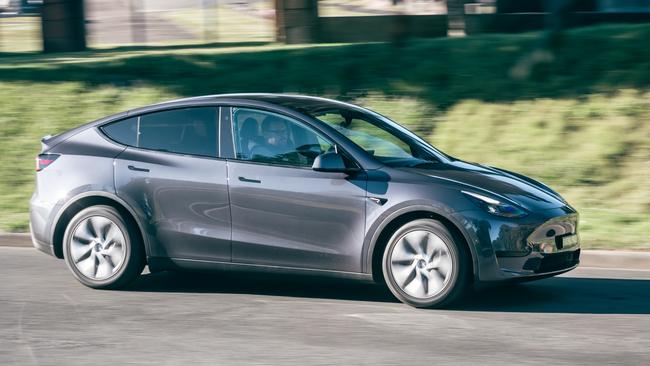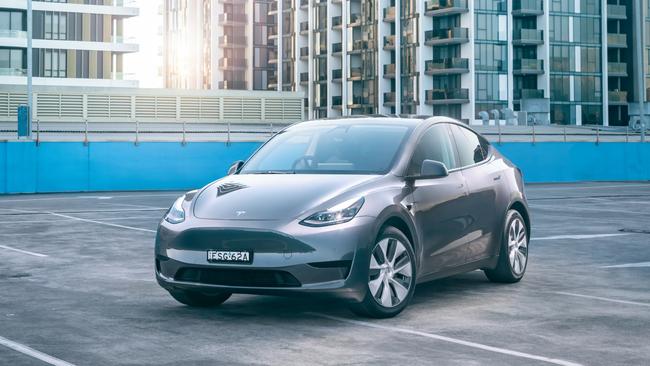2022 Tesla Model Y RWD review
Australia fans have been waiting a long time for this new hype machine, we put it through its paces to see if it’s been worth the wait.
New Cars
Don't miss out on the headlines from New Cars. Followed categories will be added to My News.
The vast expanse of daylight between electric-vehicle sales leader Tesla and the rest of the car industry is about to become bigger as the Model Y SUV arrives Down Under.
The Model 3 sedan already dominates electric vehicle sales in Australia. Despite supply issues, the Model 3 has attracted 4500 buyers in the first five months of the year, more than half the total EV market in this country.

When you consider that sedans are seriously on the nose with Australian car buyers, that’s a monumental effort.
But sales of the Model 3 are likely to be handsomely eclipsed – and potentially cannibalised – by the new Model Y, which will capitalise on Australian car buyers’ obsession with SUVs.
Tesla opened the order books for the Model Y on June 10, telling customers who signed up for the rear-drive model they would get their cars delivered between August and November this year. By June 14, the delivery times were out to between February and May next year. Deliveries of the dual-motor performance model were expected to start in November, but that has been pushed back to February.

It’s impossible to know how many vehicles have been ordered because Tesla is notoriously secretive about its order books, but the initial rush prompted Tesla founder Elon Musk to tweet: “We’re working on accelerating RHD (right-hand drive) Model Y production. Didn’t expect demand to be so high!”
Tesla upped the price of the Model Y RWD by $3400 within a week of it going on sale to about $78,000 drive-away.
It misses out on the circa-$3000 EV subsidies offered by state governments, but buyers in NSW will be entitled to a stamp duty refund of about $2600.
The cheaper Model 3 qualifies for state government rebates, so in practice the Model Y will cost roughly $10,000 more.

A couple of hundred kilometres behind the wheel suggests that won’t be a barrier to most.
The Model Y is basically a different body on the same underpinnings as the Model 3. It’s about 4cm wider, 5cm longer and 18cm taller but the electric motor and battery are the same. The rear-drive model weighs roughly 150kg more than the Model 3, which blunts its acceleration. Tesla says the Model 3 will reach 100km/h in 6.1 seconds and the Model Y takes 6.9 seconds. Claimed range is 455km, down from 491km on the 3. The dual-motor all-wheel drive version, which will cost about $105,000 drive-away when it arrives, bumps up the range to 514km and cuts the 0-100km/h time to just 3.7 seconds.
Our test route included a large chunk of freeway – where EVs are less efficient because they can’t recover charge through braking – and indications were it was good for about 410km. The claimed range could be achievable in urban driving.

The quoted 0-100km/h time is unflattering, too. Acceleration feels hot-hatch fast off the mark but the Model Y is most impressive when asked to overtake at speed. There’s an instantaneous and relentless surge of power when you hit the throttle.
The Model Y feels composed through the bends. You can feel its two-tonne mass shifting through tighter corners but the precise steering and excellent grip boost driver confidence. The Model Y is adept at ironing out rippled road surfaces and settles well after bigger bumps, although the ride feels a little bumpier than the Model 3.
Inside, the Model Y feels noticeably more spacious than the Model 3, especially in the rear where the higher roof and wider footprint liberate more leg and head room. The flat floor means passengers in the middle rear seat don’t have to splay their legs over a transmission tunnel. There’s also plenty of room for feet underneath the front seats.

Room feels on par with large diesel SUVs such as the Kia Sorento and Hyundai Santa Fe, which cost similar money. Cargo space with the rear seats folded is an impressive 2158 litres, which just shades the Sorento’s 2011 litres. The Model 3 can take just 649 litres.
The Model Y’s cabin maintains the Model 3’s minimalist design. There are no buttons or dials and everything – including opening and closing the glovebox – is done via the 15-inch landscape-oriented centre screen.
Other makers have more user-friendly and less distracting systems, as well as smartphone mirroring absent on the Tesla, but the navigation is about the best in the business and the audio system is a cracker, with pumping base and impressive clarity.
Panel gaps aren’t as precise as Japanese and European rivals, rear vision is very poor and the full-length glass roof could prove problematic on a hot Australian summer, but overall the Model Y is a class act.
VERDICT 4/5
The Model Y sets a new benchmark for electric SUVs with impressive acceleration, a classy cabin and composed roadholding.
TESLA MODEL Y RWD VITALS
PRICE From about $74,300 drive-away
WARRANTY/SERVICE 4 years, 80,000km, no fixed price servicing
SAFETY 7 airbags, auto emergency braking, lane-keep and blind-spot assist, rear cross-traffic alert, active cruise
MOTOR Single motor, power est: 192kW/420Nm
RANGE 455km
BOOT 854 litres
Originally published as 2022 Tesla Model Y RWD review



